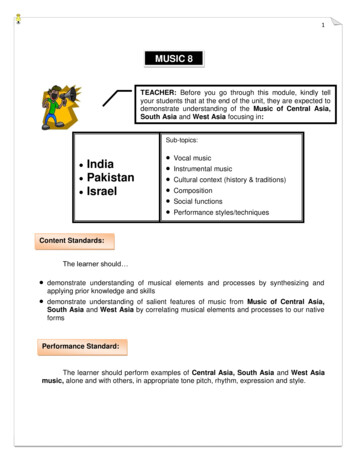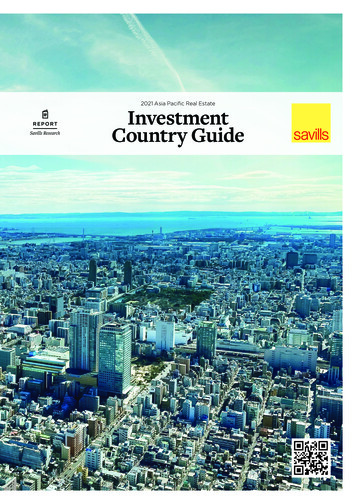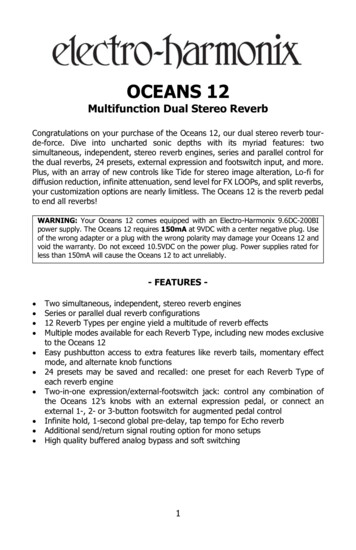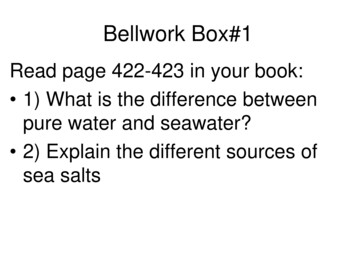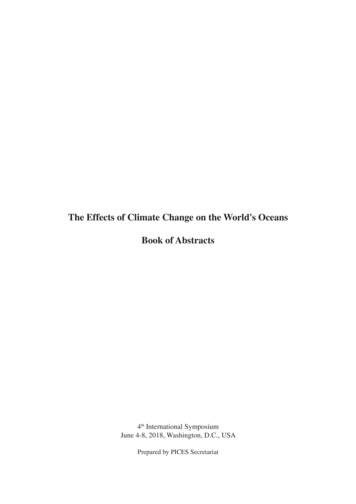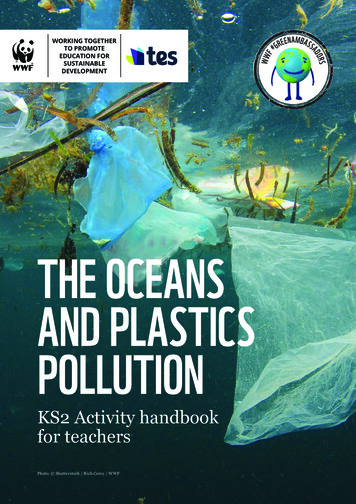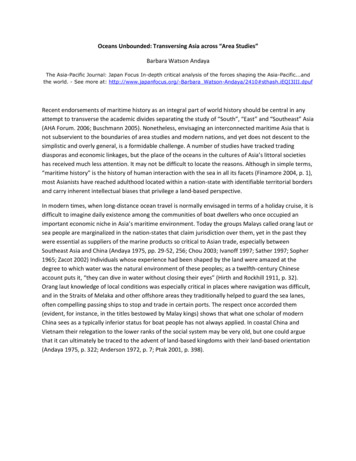
Transcription
Oceans Unbounded: Transversing Asia across “Area Studies”Barbara Watson AndayaThe Asia-Pacific Journal: Japan Focus In-depth critical analysis of the forces shaping the Asia-Pacific.andthe world. - See more at: http://www.japanfocus.org/-Barbara Watson-Andaya/2410#sthash.iEQI3III.dpufRecent endorsements of maritime history as an integral part of world history should be central in anyattempt to transverse the academic divides separating the study of “South”, “East” and “Southeast” Asia(AHA Forum. 2006; Buschmann 2005). Nonetheless, envisaging an interconnected maritime Asia that isnot subservient to the boundaries of area studies and modern nations, and yet does not descent to thesimplistic and overly general, is a formidable challenge. A number of studies have tracked tradingdiasporas and economic linkages, but the place of the oceans in the cultures of Asia’s littoral societieshas received much less attention. It may not be difficult to locate the reasons. Although in simple terms,“maritime history” is the history of human interaction with the sea in all its facets (Finamore 2004, p. 1),most Asianists have reached adulthood located within a nation-state with identifiable territorial bordersand carry inherent intellectual biases that privilege a land-based perspective.In modern times, when long-distance ocean travel is normally envisaged in terms of a holiday cruise, it isdifficult to imagine daily existence among the communities of boat dwellers who once occupied animportant economic niche in Asia’s maritime environment. Today the groups Malays called orang laut orsea people are marginalized in the nation-states that claim jurisdiction over them, yet in the past theywere essential as suppliers of the marine products so critical to Asian trade, especially betweenSoutheast Asia and China (Andaya 1975, pp. 29-52, 256; Chou 2003; Ivanoff 1997; Sather 1997; Sopher1965; Zacot 2002) Individuals whose experience had been shaped by the land were amazed at thedegree to which water was the natural environment of these peoples; as a twelfth-century Chineseaccount puts it, “they can dive in water without closing their eyes” (Hirth and Rockhill 1911, p. 32).Orang laut knowledge of local conditions was especially critical in places where navigation was difficult,and in the Straits of Melaka and other offshore areas they traditionally helped to guard the sea lanes,often compelling passing ships to stop and trade in certain ports. The respect once accorded them(evident, for instance, in the titles bestowed by Malay kings) shows that what one scholar of modernChina sees as a typically inferior status for boat people has not always applied. In coastal China andVietnam their relegation to the lower ranks of the social system may be very old, but one could arguethat it can ultimately be traced to the advent of land-based kingdoms with their land-based orientation(Andaya 1975, p. 322; Anderson 1972, p. 7; Ptak 2001, p. 398).
Orang Laut houseboat, Riau Archipelago 1991. Courtesy of Cynthia ChouOrang Laut woman preparing food, Riau Archipelago 1991. Courtesy of Cynthia Chou
Though now rarely attempted, the possibility of cross-cultural comparisons among such sea-orientedcultures opens up interesting potentials for research. For instance, the concept of compass coordinatesis not necessarily congruent with the indigenous knowledge of non-Western societies; the spatialorientation of peoples who spend most of their time at sea has therefore been a topic of considerableinterest for specialists in Indonesia and the Pacific. It might be illuminating to ask whether directionssuch as north and south are related to “up” and “down” among sea-going communities in other areas ofcoastal Asia as they are in the huge Austronesian linguistic family that covers most of the Pacific andisland Southeast Asia. (Blust 1997, pp. 38, 48; Adelaar 1997, pp. 53-81; Sather 1997, p. 93). Let meprovide a visual example from the Galela people of Halmahera, in eastern Indonesia. The map shownhere, drawn by a Japanese scholar, represents Halamahera and the surrounding area upside downbecause according to the Galela orientation system, which is related to the monsoon winds and a landsea axis, “up” lies in a southerly direction, and “down” is to the north (Yoshida 1980, pp. 36-37).Galela perspective on the world (Yoshida 1980: 36)The inherited vigilance of societies whose existence is closely calibrated with the rhythms of the sea, andwho maintain an ability to read nature’s portents, was dramatically demonstrated nearly two years ago,when a terrible tsunami devastated so much of the area around the Indian Ocean. It was reported thatisolated groups on the Andaman and Nicobar Islands in the Bay of Bengal recognized warning signs likechanges in bird cries and the behavior of land and marine animals. They therefore moved to higherground well in advance of the destructive walls of water that penetrated so far inland. Nonetheless,although many communities are still living with the tragic results of December 2004, the Asian seas areknown less for their ferocity than for their long function as a medium for connecting quite distantregions through the exchange of people, goods, and ideas. It is the human dimension that makes this
interlocking relationship between land and ocean such a compelling teaching device. If we insist that thesea and those who live with the sea deserve a more prominent place in our study of Asia, we will take animportant step in developing the framework required for any comparative overview. In turn, thisframework will go a long way towards overcoming the confines of so-called area-studies whileredressing the scholarly preoccupation with land-based societies that has so informed the presentationof Asian cultures.Relief from Borobudur, central Java. Courtesy of John MiksicA shift in orientation is not necessarily an easy task, for the polities and governments whose narrativesdominate historiography have rarely seen the oceans as an integral part of their territorial domain.More frequently, the sea is regarded as a boundary, separating land inhabitants from other landinhabitants. As John of Gaunt proclaimed in Shakespeare’s Richard II, the “silver sea” served England, “inthe office of a wall/ Or as a moat defensive to a house/Against the envy of less happier lands”(Shakespeare 2003, pp. 96-97). In India, despite a long tradition of maritime trade, Hindu insistence onthe need to maintain ritual purity judged sea travel polluting for those of high caste, and by thetwentieth century self-imposed restrictions were even being accepted by some Sudra groups (Bindra2002, p. 36). Ming prohibitions forbidding coastal dwellers to cross the seas except as a member of anofficial mission were clearly ineffectual. Nevertheless, a perception of the ocean as marking off animagined set of land dwellers from the “other” are apparent in a sixteenth-century Chinese map, inwhich the cartographer inserted a stylized sea separating China from the area we now know as mainlandSoutheast Asia (Teng 2004, p. 37; Wade 2004, p. 6).Even as representatives of land-based kingdoms took to the sea with the goal of reaching places onlydimly imagined, the sheer immensity of the earth’s oceans was daunting; after all, they cover 70.8percent of the earth’s surface. In these ventures the trepidation aroused in contemplating the unknowncould be allayed through explanation and classification that made the unfamiliar imaginable. In thetenth century, for instance, the geographer Al-Muqaddasi affirmed that “the realm of Islam” wasencircled by just one ocean “and that this is known to everyone who sails,” but he also acknowledged
that Muslim treatises often spoke of three, five, or eight seas (Chaudhuri 1985, p. 4; Collins 1974,pp.148-64; see also Lewis 1999). On the other side of the world China’s scholars also became caught upin efforts to categorize the known “oceans” and “seas”. Within a larger “Western” and “Eastern” Ocean,Chinese cartographers identified smaller sectors on the maritime routes to Africa, a technique thatallowed large expanses of water to be visualized simply as highways linking one land area to another. Amap produced following Zheng He’s expeditions thus depicts the Indian Ocean as a schematized corridorbetween India to the north and Arabia to the south (Needham 1954, 3, p. 560; Ptak 2001). A similarprivileging of the land appears among early Portuguese and Dutch cartographers, who scattered thenames of rivers, mountains, and towns across their maps of Asia, but presented the sea as a fancifuldomain of belligerent whales, pitching ships and seductive mermaids (SuaÌ rez, 1999, pp. 166-67).Ultimately, however, it was European cartography that identified and named the world’s oceans as weknow them today– the Atlantic, the Arctic, the Indian, the Pacific and, in 2000, the Southern Ocean –with boundaries created when necessary; in the Southern Hemisphere, for instance, the Atlantic isseparated from the Pacific by an artificial line drawn from Cape Horn to Antarctica. Even so, the humancapacity for categorization is indefatigable, and within these five oceans the International HydrographicBureau currently identifies as many as fifty-four different seas.To a considerable degree this desire for categorization, like national borders on the land, has createdboundaries and subsets for academic inquiry. Several universities maintain Centers of Pacific Studies; wehave a center for Arctic Studies in Washington, D.C. and various Centers of Atlantic Studies are locatedin European and U.S. institutions. We are all familiar with Braudel’s notion of the special character of theMediterranean, “a sea . . .so alive, so eternally young” (Braudel 2001), and his work has inspired manydisciples. Barry Cunliffe has spoken of an “Atlantic mystique” linking coastal peoples like the Celts,Bretons, and Galicians, who had more in common with one another than they did with their inland kin.(Cunliffe 2001)[1]In Asian Studies the fine detail this focused research can produce is most evident in regard to the IndianOcean, the world’s third largest. A subfield in its own right, “Indian Ocean Studies” can now supportdedicated journals, conferences, and summer institutes. Further refinements are possible even withinwhat would seem a very specific domain, and we thus find specialists on the “Eastern” and “Western”Indian Oceans. As Asianists, we are more familiar with the “eastern” orientation, although our viewmight change somewhat if we were interested, for instance, in the extensive networks of Arab tradethat connected Africa to India and beyond.[2] Indeed, in his latest book, A Hundred Horizons, SugataBose joins others (2006; Pearson 2003) in arguing for the organic unity of the Indian Ocean by tracingthe economic and cultural communication that made it an integrated and interregional arena well intothe twentieth century.As the geographer Martin Lewis has noted, these divisions of “sea space” do allow for effectivecommunication among people with like interests. There is, however, a danger that our imaginations canbe directed “along certain preset pathways . . . that reflect specific cultural and political outlooks” (Lewis1999, p. 211). In light of this comment, it is interesting to note that Southeast Asia – located betweentwo of the world’s great oceans – remains a shadowy presence even when the theme of “maritime Asia”
is employed. Nearly thirty years ago Donald Emmerson made a strong case for a “maritime perspective”on Southeast Asia (Emmerson 1980), and if we agree that greater attention should be given to the roleof the sea in Asian communities, then Southeast Asia is a good place to begin. In the Malay-Indonesianand Philippine archipelagoes, for instance, between 95 and 100 percent of the population lives within100 km of the coast and these cultures still posses the world’s “richest residue” of ancient maritimetechnology (Lewis 1978, p. 63). Historical discussions of mainland Southeast Asia typically emphasize thecultural and economic base in agriculture, but it is worth remembering that 40 percent of Thailand’spopulation, and over 80 percent of people in Vietnam, live in areas designated as coastal.[3] As onegeographer has put it, “the degree of marine influence over the environment, settlement,communication and development of resources, both in Mainland and Island Southeast Asia, is probablyunmatched in any other part of the world.” (Barrow 1990, p. 78)In this context, the uniqueness of Southeast Asia can also be attributed to its location at the crossroadsof Asia’s seaborne trade. The maritime connections between China and India through Southeast Asia arewell documented (Hall 2006), but it is also useful to remember that winds and ocean currents linkedsouthern Japan and the Ryukyu Islands to Taiwan and the Philippines, and that there are a range oflinguistic and cultural similarities that go well beyond coincidence (Kumar and Rose 2000; Toichi, 1974;Waterson 1990, pp.15-17). Although the policy of sakoku under the Tokugawa shogunateinstitutionalized the idea of the sea as a barrier, the Japanese effort to present itself as a maritimepower after 1941 can be seen as an attempt to revive earlier traditions. Included in a royal Ryukyuanthology of 1531, the chant of a priestess who summons the spirits of Japan, China, Java and “thesouthern seas” is compelling evidence of this older vision (Hokama 1998, p. 256).[4]As innumerable studies have shown, one of the most effective means of tracking such connections inearly times is through a consideration of trade. It is not enough, however, just to talk about port citiesand maritime routes, and to treat the oceans as simply a “transport surface,” a medium by whichproducts and trade goods moved from one place to another. If we accept that explorations ofresemblance and divergence may themselves be illuminating, we need to imagine the human realitythat initiated and sustained commercial exchanges along ocean pathways. In viewing the seas as a spacefor creative human activity (Lowe 2003, pp. 121-122; Steinberg 2001, p. 46), we can only wonder at thehuman ingenuity that developed the sailing technology required to link far-flung areas, and that locatedand provided much-desired products for distant and unknown consumers. Is it not amazing, forexample, that early communities in tropical Asia discovered how to roll the fibers of the sugar palm(Arenga pinnata) together sufficiently tightly even to lash a boat together? Or that resin from the Rhusvernicifera (Japanese lacquer) tree mixed with sawdust, shredded bamboo, or water-buffalo dung couldbe used for caulking (Burningham 1994, p. 223, Manguin 1985, p. 336)? Equally remarkable is thedistance traversed by certain items that may have little significance in today’s commercial world. Humancooperation over thousands of miles thus meant that beads made in Europe, Africa, the Middle East,India, China or Java could become prized heirloom possessions of buyers as far afield as Timor and Palau(Francis 2002).
Bamboo basket boats, Vietnam, 2000. Traditionally caulked with resinand fillers such as sawdust, shredded bamboo or cattle dung. CourtesyUniversity of Hawai‘i Center for Southeast Asian Studies picture archiveLet us take as another example the case of cowry shells. Although the species of cowries used for money(Cypraea moneta) was widely distributed through the Indo-Pacific area, the best come from theMaldives, and it was the commercial production here (breeding shells on palm fronds and other leafmatter lying in shallow water) that supplied Cypraea moneta for most of the world’s trade until theeighteenth century. The tentacles of these operations were far-reaching; in Yunnan a cowry-basedsystem of exchange for paying taxes, buying land, and making donations was well established by theninth century CE and continued until the seventeenth century (Yang 2004). Another area where cowrieswere much used was northern Thailand, with local rulings that were often very precise: for example, onelaw code specifies that if an officer “grasps the breasts of a woman who is willing” he should be fined22,000 cowrie shells, but (to our mind, paradoxically) only half the amount if he puts his hands insideher blouse (Wichienkeeo and Wijeyewardene 1986, pp. 22, 29). It seems that these networks linkingBengal and coastal Southeast Asia only declined with the expansion of Han control into Yunnan and anexpanding globalized market based on coinage.
Cowry trade (Yang 2004. Used with permission)A third trade item that might pique student interest is the edible holothuria, the sea slug or teripang.Again, tracking the distances covered by what early Europeans called a “repulsive” product requires usto think far beyond area-studies boundaries, and serves, if we need it, as another reminder of the greatlengths to which human beings will go to satisfy the demands of commerce. Although teripang occurthroughout the world’s oceans – there are in fact about 1200 known species – the greatest diversity andthe largest numbers were found among the islands of Southeast Asia and adjacent areas. The primaryconsumers in the early modern world were in China, where by the late Ming period sea slugs werestandard in most banquets. The increasing demand fueled an expansion of the teripang trade,particularly in eastern Indonesia, where remote islands became drawn into a global exchange. As themarket grew, even northern Australia became a major area for teripang collection, primarily by Bugisand Makassar traders from Sulawesi. Evidence of stone fireplaces, tamarind trees, and Muslim gravessupply material evidence of their presence, as does Aboriginal art, linguistic borrowings, and legend(Macknight 1976). The gathering of sea cucumbers, still an important trade today, provides an intriguingexample of a complex train of relationships that, as in the case of beads or cowries, encourages us tothink of the manifold ways in which the sea has facilitated human interaction.
Makassar fishermen smoking teripang for the China trade, 1845.Port Essington, North Australia,(Macknight 1976, plate 11. Used with permission)Comparisons of the cultural environments that are enmeshed in these attenuated chains ofcommunication also deserve attention, for it is here that the human dimension most clearly emerges. Ican only reiterate that there are interesting possibilities for comparison across Asia and for testing theproposition that littoral societies “have more inc common with other littoral societies than they do withtheir inland neighbors (Pearson 2006, p. 353). Does the received wisdom that women in seagoingcommunities are relatively independent still hold among, for instance, the pearl divers of Japan andSouth Korea (Cho 1989; Martinez 2004, p. 47; Norr and Norr 1974, p. 249)? In what ways do culturalsingularities explain the differences between female fish traders in southern India and those in thecoastal areas of Vietnam or Indonesia (Pham 2004; Ram 1989; Volkman 1994, pp. 574-76)? Although ananthropologist might urge her colleagues to accept the sea as a “place” that, like the land, generates“creative human activity,” any historical investigation faces real challenges; as Roderick Ptak has pointedout, official Chinese sources dealing with seafaring rarely reflect the views of ordinary sailors andmerchants, and there is little room for integrating China’s coastal towns and provinces into a maritimesetting (Lowe 2003; Ptak 2001, p. 401). Nevertheless, because our academic orientation is normallyterritorially grounded, we may have overlooked material that is available to us and in the process haveunderestimated the importance of the sea-land experience in our representations of Asia. In a recentarticle Charles Wheeler calls for a “re-thinking” of the place of the sea in Vietnamese history. In hiswords, “We typically invoke the centrality of water in Vietnamese cultural life, whenever we talk to ourstudents.” However, with few exceptions, he goes on, the historical evidence of the sea’s significancehas remained only supplementary to interpretations that present Vietnam as an “enclosed, earthbound,
agrarian society” (Wheeler, 2006, p.126)In responding to this comment, I turn to the island-rich environment of insular Southeast Asia, [5] andparticularly to those areas of the Austronesian world where the symbolism of the sea and of boats isintegral to political and social systems (Coedès 1968, pp. 3-4). The intimate relationship between landand sea so clearly articulated in these systems should encourage participants in larger conversations tothink more seriously about the place of the oceans in Asian states traditionally characterized as agrarian.In a 1984 conference on Southeast Asia, Pierre-Yves Manguin (1986) spoke of “ship-shape societies” andthe range and variety of references he assembled remains impressive. Although some scholars havecautioned against over-reading this symbolic language (Waterson 1990, pp. 20, 93), one cannot denythat the migration of ancient Austronesian-speaking peoples from southern China or Taiwan would havebeen by boat or that words connected with boating and sea travel are prevalent in linguisticreconstructions of proto-Austronesian vocabularies (Pawley and Pawley 1994, p. 329; Zorc 1994, pp.543-45). More than three thousand years later, when the Spanish first reached the Philippines in 1521,boats were still the only means of long-distance transport, and there is no evidence of wheeled vehicles(Scott 1994, p. 5).Island Southeast AsiaIn this context, historians can gain much from conversations with archaeologists. The boat-shapedcoffins found throughout this water-connected world, often in locations that face the sea, provideconvincing evidence that many early societies thought of the afterlife as a place that would be reachedafter a voyage across water. Indeed, the words for “boat” and “coffin” are sometimes interchangeable,and from very early times “ships of the dead” are a recurring motif in Southeast Asia’s indigenous art(Ballard et al 2004, pp. 394-97; Glover 1972, p. 42; Manguin 1986, pp. 193, 196). A striking example of
this imaginaire is found on the cover of a well-preserved burial jar discovered in a cave complex on theisland of Palawan in the Philippines. Shown in their voyage to the next life, both boatman and passengerwear a band tied over the head and under the jaw, a style of laying out a corpse still found in thesouthern Philippines centuries later (Fox 1970, pp. 113-114, 123). It is unclear whether any parallelsexist between the boat coffins in Southeast Asia and ancient boat burials found in China’s Sichuanprovince, although in both places this mode of interment seems to have been associated with the elite.In the seventeenth century Spanish missionaries thus talked of Filipino chiefs buried in boats “which thenatives call barangay”; in one such instance, the body was surrounded by seventy slaves, ammunitionand food “as if he were to be as great a pirate in the other life as this” (Blair and Robertson 1903-9, 7:194; 40: 81; Quirino and Garcia 1958, pp. 396, 415-16; Sage 1992, pp. 67, 140)Cover of burial jar representing souls sailingto the afterworld, Palawan, Philippines(Fox 1970:114)The symbolism that linked the sea to the land is also apparent in the house architecture of numerousIndonesian cultures. Though the derivations of curved and allegedly “boat-shaped” roofs in certainsocieties have been debated (conversely, the best known are the inland societies of Minangkabau andToraja), studies of communities in eastern Indonesia, notably between Timor and Tanimbar, persistentlyemploy boat terminology in reference, for instance, to the main posts (“masts”) of the house and thespace under the high roofs (“sails”) as well as to other architectural features like the “keel” or “rudder”(de Jonge and van Dijk 1995, pp. 33-34, 74-77; Manguin 1986, pp. 190, 204 n17; Vroklage 1940, pp. 263,265, 266;). Even when villages are located at some distance from the coast and the economy is based onagriculture rather than seafaring, the association between boats and the human community can stillapply, albeit adjusted to an inland environment. In the Sahu (northern Halmahera) village described byLeontine Visser, the ceremonial house is compared to a perahu pulled up on land (kagunga tego-tego)rather than a seagoing boat (Visser 1989, p. 177). Equally, it is not uncommon to find that household
relationships are expressed in terms of shipboard life. An early seventeenth-century Bicol dictionaryfrom the Philippines thus glosses the word laygay as both “in command of a ship” and “to issue orders incharge of servants and slaves in the house” (Mintz 2004, 2: 704). More intimately, a kelong, a genre oftraditional Makassarese poetry, imagines the union of a husband and wife as being “like two fishingboats/Fishing together the big shiny fish /Tied together for life’s long voyage” (Knappert 1999, p. 94; cf.Gonda 1947, pp. 101-05).Minangkabau house near Bukkitinggi, Sumatra, 2004.Courtesy of Sara OrelAs one might expect, similar metaphors also can be found in regard to community organization. Theearliest historical references again come from the Philippines, where Spanish friars noted that thesmallest political unit of Tagalog society was called a barangay, or boat (Blair and Robertson 1903-9,40:83; Manguin 1986, p.189). The same heritage, however, is found through much of eastern Indonesia,and it is against this background that we read the names of villages in central Flores, like Laja (sail), Udi(rudder), Mangu Lewa (high mast), or Kutu (great oar length), and of headmen honored with titles suchas “steersman,” or “leader of the great perahu” (de Jonge and van Dijk 1995, pp. 40, 55; Röder 1939, pp.100-1; Vroklage 1940, pp. 268-269). As Visser (1989. p. 177) has noted, the metaphorical conception ofthe village center as a perahu is widespread in the Austronesian world, but the cultural dynamics of acommunity built around the concept of a boat have been most graphically described in the TanimbarIslands in eastern Indonesia. In 1940 Petrus Drabbe published his remarkable account of pre-Christianvillages located on cliff-top sites, where the center and place of worship was built in the shape of a stoneboat, and in one case was even equipped with an anchor taken from a shipwrecked Dutch steamer.When men were absent on long-distance trading voyages a “crew” of women maintained watch on land.
Assuming the same positions as men on a ship – captain, jurumudi (in charge of steering), or jurubatu(responsible for the anchor) – they followed prescribed rituals until the boat returned (Drabbe 1940, pp.47-51, 140-41). A more recent study by Susan McKinnon has recorded the persistence of many of thesepractices, including the ceremonial language and dance formations that celebrated the unity of a boatand its crew, and the “friendship voyages” by which intervillage alliances were renewed. Encoding thevillage as a perahu lying at anchor, she suggests, the stone boat imparted a sense of unity and stabilityto a people whose cultural memories were infused with legends of migration and resettlement (deJonge and van Dijk, pp. 76-81; McKinnon 1988, pp. 165-66; 1991, pp. 68-83).Singing and dancing, people from Sera Island (Tanimbar archipelago)set out to renew their alliance with a village on Yamdena Island,1980. Courtesy of Susan McKinno
Tanimbar women dance on a stage builtin the form of a boat (from Drabbe, 1940)Boat-shaped stage, Tanimbar (from Drabbe, 1940).In eastern Indonesia a cultural order that tied the sea to the land has been most clearly identified inrelation to villages, but the same models could be easily elevated to higher levels of governance. On theother side of the archipelago the notes accompanying a precolonial map of the Malay state of Perakthus explain that the raja is the captain and that the duties of ministers mirror those of crewmembers,with one identified as “he who wields the starboard paddle” and another “the person who bales theboat if she leaks (Andaya 1979, p. 28; Manguin 1986, p. 193; Shellabear 1885, pp.19-20). By the sametoken, it was these ruler-centered courts that produced Southeast Asia’s impressive corpus of maritimelaw, providing judicial advice for a multitude of problems that could develop during a voyage, duringtrading negotiations, or when a ship made landing. “The captain is as a king on board his ship; thesteersman is like the prime minister; the person in charge of casting anchor and taking soundings is likethe chief of police.” Crewmen were expected to follow the same standard of conduct as they would onland, particularly in regard to married women, and one article reads: “Anyone using a mirror facingtowards the bow of the ship commits a serious offence, since the captain’s wife or concubine might beon board [and her image be reflected]. The punishment is seven lashes and a fine of gold” (Winstedt andde Josselin de Jong 1956, pp. 32, 49, 51, 58).In promoting the comparative framework that lies at the heart of area studies, one obvious approachwould see differences and similarities among sea-oriented communities primarily in economic terms,because their livelihood is so clearly reliant on access to the water and its resources. In the words of afemale fish trader in Mandar (southwest Sulawesi), “our garden is the sea” (Norr and Norr 1974;Volkman 1994, pp. 567, 569). There are however, more intangible dimensions. As Raymond Firth and
others have emphasized, the uncertainty of a fishing-based economy is great, since “the yield isprecarious, the risk considerable,” and the spirits of the sea required constant and unremittingpropitiation if the fisherman (or occasionally fisherwoman) was to be successful (1984.p. 1147; Kalland1995, pp. 42-50). In the Philippines the Spanish friar Francisco Colin mention
1999, p. 211). In light of this comment, it is interesting to note that Southeast Asia – located between two of the world’s great oceans
